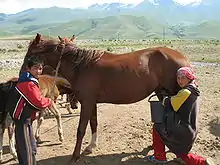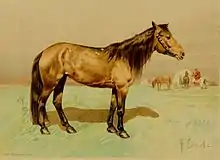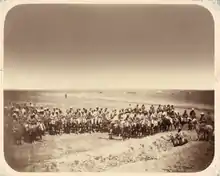Kyrgyz Horse
The Kyrgyz Horse or Kirgiz Horse is a traditional breed of small horse from the Kyrgyz Republic (Kyrgyzstan).[2] Kyrgyz people associate it with their nomadic past.[4]:12 During the Soviet era of Kyrgyz history, the Kyrgyz Horse was cross-bred with imported foreign breeds, including Don and Thoroughbred strains, to create a new and larger breed, the Novokirgiz or New Kirgiz.[3]:489
 A mare being milked in Suusamyr, Kyrgyzstan | |
| Conservation status | FAO (2007): not at risk[1]:81 |
|---|---|
| Other names | |
| Country of origin | Kyrgyz Republic |
| Distribution | nation-wide |
| Use | |
| Traits | |
| Height |
|
| Colour | dark colours grey |
| Breed standards | |


History
In the late nineteenth century there were some two million Kyrgyz horses in the area that is now Kyrgyzstan.[5] During the Soviet era, the traditional Kyrgyz horse was cross-bred with larger but weaker imported foreign breeds, including Don and Thoroughbred strains, to create a new breed, the Novokirgiz or New Kirgiz.[3]:489[5] Numbers of the traditional native breed were greatly reduced,[5] but have since shown some recovery.[6] The population of the Kyrgyz breed was last reported to DAD-IS in 2002, when the total population was 78 300 head.[2] In 2007 its conservation status was recorded by the FAO as "not at risk".[1]:74
An association for the protection of the Kyrgyz Horse, the Fondation Kyrgyz Ate, was set up in Bishkek in the early twenty-first century. A breed standard was drawn up, based partly on a description found in archives in Saint Petersburg, and was approved by the national ministry of agriculture.[4]:14
Characteristics
The Kyrgyz Horse is a small mountain horse. It is sure-footed and agile, with the necessary stamina and endurance for the mountain environment.[4]:14[7] The coat may be dark or grey.[3]:480
Use
The Kyrgyz Horse is used as a riding horse, for horse-racing, and as a light harness horse. It is important for production of meat and milk.[3]:480 Horsemeat production in Kyrgyzstan in 2002 was 24 800 tonnes, about one eighth of the total meat produced in that year.[8]:14 The mare's milk is often fermented to make kumis.[4]:14
With traditional mounted games such as kok-boru (also known in Kyrgyzstan as ulak-tartysh), oodarysh (mounted wrestling) and kyz-kuumai (meaning roughly "chase the girl"), the Kyrgyz Horse may be perceived as an symbol of the pre-Soviet nomadic past of Kyrgyz people, and thus as an element of post-Soviet Kyrgyz culture and national identity.[4]:14[5][6]
References
- Barbara Rischkowsky, D. Pilling (eds.) (2007). List of breeds documented in the Global Databank for Animal Genetic Resources, annex to The State of the World's Animal Genetic Resources for Food and Agriculture. Rome: Food and Agriculture Organization of the United Nations. ISBN 9789251057629. Accessed January 2017.
- Kirgiz/Kyrgyzstan. Domestic Animal Diversity Information System of the Food and Agriculture Organization of the United Nations. Accessed January 2017.
- Valerie Porter, Lawrence Alderson, Stephen J.G. Hall, D. Phillip Sponenberg (2016). Mason's World Encyclopedia of Livestock Breeds and Breeding (sixth edition). Wallingford: CABI. ISBN 9781780647944.
- Rebecca Cassidy (2009). The Horse, the Kyrgyz Horse and the 'Kyrgyz Horse'. Anthropology Today 25 (1): 12–15. (subscription required)
- Mike Ives (8 August 2012). Kok-Boru, the Horse Game You Won't See at the Olympics. Smithsonian magazine. Accessed January 2017.
- David Trilling, Alina Dalbaeva (6 November 2008). Kyrgyzstan: Festival Celebrates the Kyrgyz Horse, Marks Revival. eurasianet.org. Accessed January 2017.
- David Trilling (7 November 2008). Kyrgyzstan: Festival Celebrates the Kyrgyz Horse, Marks Revival. eurasianet.org. Accessed January 2017.
- [s.n.] (2007). Status and perspectives of agricultural animal genetic resources (AAGR) conservation in the Kyrgyz Republic, annex to The State of the World's Animal Genetic Resources for Food and Agriculture. Rome: Food and Agriculture Organization of the United Nations. ISBN 9789251057629. Accessed January 2017.